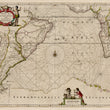





1650 Mar Di Aethiopia Vulgo Oceanus Aethiopicus
By: Jan Jansson
Date: 1650 (circa) Amsterdam
Dimensions: 17.25 x 22 inches (43.75 x 56 cm)
This map is a beautiful example of Jan Jansson’s sea chart of the South Atlantic Ocean, following the coasts of South America, South and West Africa, and Terra Australis Incognita.
Notable in this map are the winding Amazon river; the Falkland Islands (labeled as “Sebald de waerts Eylanden”), the Strait of Magellan and Tierra Del Fuego. One of the more interesting features of Jansson’s map is the depiction of the apocryphal Lake of Xarayes at the convergence of the Amazon and Paraguay Rivers. When the Spanish and Portuguese explorers first navigated up the Paraguay River in search of El Dorado, they mistook Brazil’s Pantanal floodplain for a massive inland lake. Named after the indigenous inhabitants of the area, the Xaraies, this mythical lake quickly began appearing on early maps of the region, and soon became known as the gateway to El Dorado.
Also of note is the inclusion of “de G Brouwers Passage” between Staten Island and Terra Australis Incognita. As the Dutch had always wanted to colonize parts of Chile in order to trade in gold, they decided to send an expedition there. In 1642, Dutch general Hendrick Brouwer was navigating from Brazil to Cape Horn via the Le Maire Strait as part of this expedition. While the voyage was generally a failure for the Dutch (as their efforts to break into the gold trade were almost immediately put down by the locals), Brouwers did, by chance, circumnavigate Staten Island, dispelling previously held beliefs that this small island was part of the Unknown Southern Land and was instead an island.
The map features a colorful title cartouche with a European man in Turkic dress and a man in a loincloth, presumably an indigenous man. Surrounding them are animals native to the areas depicted, including an iguana and a tortoise. Though seemingly meant to be an indigenous man, the figure is drawn with strikingly similar facial features to the cherubs depicted on the bottom of the map, suggesting a European provenance. The cherubs are shown assisting a surveyor as he looks through a sextant. Below these figures is a cartouche showing distance in German miles. The map contains sprawling rhumb lines and green and pink lines, presumably marking boundaries of different lands and territories, including islands off the coast of Terra Australis Incognita. Also included is a bright green and red compass rose in the center.
With bright color, a strong impression, beautiful illustrations, and the inclusion of mythical places like Lake Xarayes, Jansson’s map is a sterling example of Dutch cartography at its height.
Condition: This map is in B+ condition. A strong impression with two small wormholes, one off the coast of Chile and the other in South Africa. Even toning throughout. French text on verso.
Inventory #12043
1200 W. 35th Street #425 Chicago, IL 60609 | P: (312) 496 - 3622







